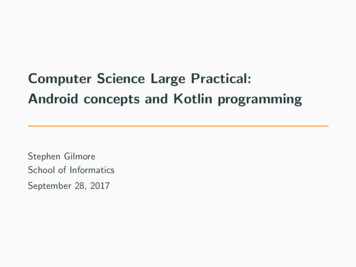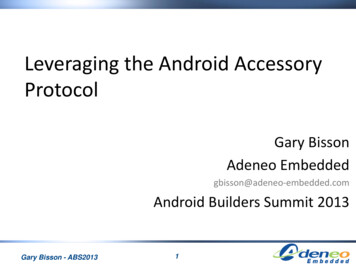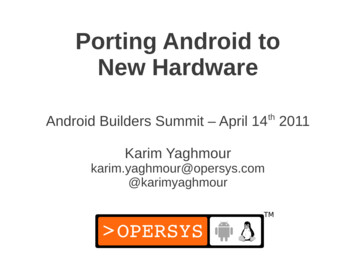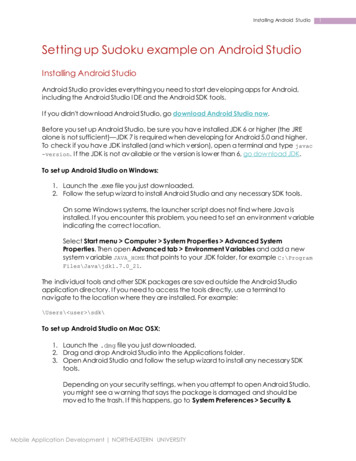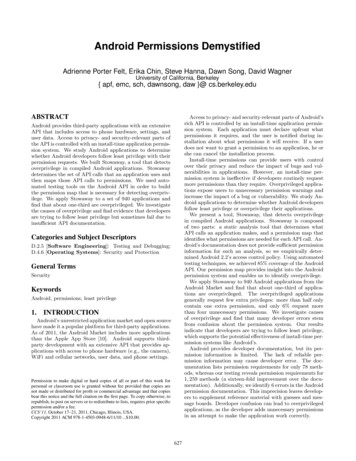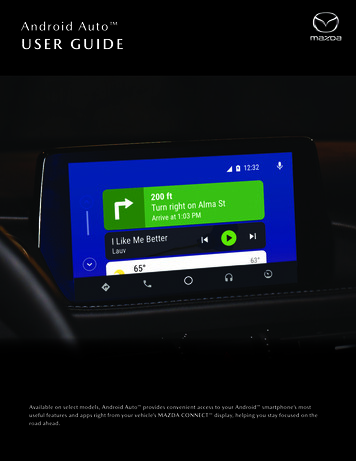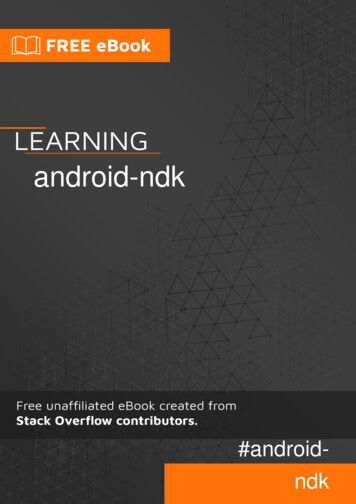
Transcription
android-ndk#androidndk
Table of ContentsAbout1Chapter 1: Getting started with android-ndk2RemarksWhat is the Android NDK?22Versions2Examples2Getting started with Android NDK with simple exampleCredits213
AboutYou can share this PDF with anyone you feel could benefit from it, downloaded the latest versionfrom: android-ndkIt is an unofficial and free android-ndk ebook created for educational purposes. All the content isextracted from Stack Overflow Documentation, which is written by many hardworking individuals atStack Overflow. It is neither affiliated with Stack Overflow nor official android-ndk.The content is released under Creative Commons BY-SA, and the list of contributors to eachchapter are provided in the credits section at the end of this book. Images may be copyright oftheir respective owners unless otherwise specified. All trademarks and registered trademarks arethe property of their respective company owners.Use the content presented in this book at your own risk; it is not guaranteed to be correct noraccurate, please send your feedback and corrections to info@zzzprojects.comhttps://riptutorial.com/1
Chapter 1: Getting started with android-ndkRemarksWhat is the Android NDK?Android Native Development Kit (NDK) is a companion tool to Android SDK that allows portions ofapps to be built in in C/C . This is useful for: Sharing application components across platforms (Android, iOS, Linux, etc.) Improving performance for critical portions Reusing existing C/C librariesThe NDK provides headers and libraries that allow the developer to build activities, handle userinput, use hardware sensors, access application resources, and more - all the while programmingin C/C .VersionsVersionRelease sGetting started with Android NDK with simple exampleUsing Android Studio 2.2 and higher Native Development Kit (NDK) you can use to compile C andC code.You can use NDK by manually downloading NDK and build it or through CMake .Here I will give process flow for manually install NDK and an example code,Based on your System OS you can download NDK from this s/index.html.After downloading, give the path in System Environment Variable as variable name “NDK PROJECT PATH” and variable value “location of NDK stored path”.https://riptutorial.com/2
Next, to integrate NDK with Android Studio, after creating a new android project,In gradle – local properties add location of sdk path likesdk.dir Ndk true Then, Press Build – Make Project (Ctrl f9).Your project will be successfully build and will get BUILD SUCCESFUL in message gradlebuild, as shown belowhttps://riptutorial.com/3
Then in Terminal, initially it will contains project’s pathThere add cdapp/src/mainPath will extend from project path to main.Next, again Build – Make Project (Ctrl f9).Now you will find under app-build–intermediates–classes–debug folder, as shown below.https://riptutorial.com/4
Now, create a new Java Class file under a app/src/main/java , Here I created java file namedNativeClasshttps://riptutorial.com/5
Write a simple calling function with function name and input for the function, Here I written functionas example and given two integer input to it,https://riptutorial.com/6
Again build the project (Ctrl f9),When you build, you will find the class file created under build like this,Then,in terminal -Javah -d jni –classpath././build/intermediates/classes/debug application.com.ndkapplication.NativeClasswhere , -d – for output directory -jni -Generate JNI-style header file (default) -classpath -- forwhich to load classesNow build the project (Ctrl f9), you will find jni folder created and a header file will be createdwith the name you specified in terminal before as shown belowhttps://riptutorial.com/7
Now copy header file and save as .cpp or .c file of same name of header file in jni folder .I created a cpp file as shown belowDelete everything before **JNIEXPORT line** in this file and **add header file name** alone.Here I am for simple example just adding two numbers and returning value to android java.https://riptutorial.com/8
Application com ndkapplication NativeClass.cpp#include application com ndkapplication NativeClass.h JNIEXPORT jint JNICALL Java application com ndkapplication NativeClass example(JNIEnv *, jclass , jint as , jint bs){return (as bs);}And for this example no need to add any function in its header file.Create a new file named Android.mk and Application.mk in Jni folderAndroid.mk file is to describe your sources to the build system.Android.mkLOCAL PATH : (call my-dir)include (CLEAR VARS)LOCAL SRC FILES : application com ndkapplication NativeClass.cppLOCAL LDLIBS -llogLOCAL MODULE : exp-jniinclude (BUILD SHARED LIBRARY)to know detail about this file read from this id mk.htmlhttps://riptutorial.com/9
Application.mk which describes the native modules that your app requires.Application.mkAPP STL : gnustl staticAPP CPPFLAGS : -frtti –fexceptionsAPP ABI : armeabi-v7a armeabi arm64-v8a mips mips64 x86 x86 64APP PLATFORM : android-16to know detail about this file read from this cation mk.htmlhttps://riptutorial.com/10
Now build the project again **(Ctrl f9)**, you will find the **armeabi-v7a, armeabi, arm64v8a ,mips, mips64, x86 and x86 64** folder created inside jniLibs.Then, in main activity pass the input and get output for native class file.int a 5, b 5, res ;res NativeClass.example(((int) a),((int) b));TextView textView (TextView) this.findViewById(R.id.tv);textView.setText(new Integer(res).toString());here I given two integers input through a, b and get output from variable res .And obtained output is displayed in screen by passing to TextView.And don’t forget to add the library which you specified in Android.mk file as LOCAL MODULElike this,static {System.loadLibrary("exp-jni");}Finally build the project again (Ctrl f9), you will find the .so files created under each armeabi-v7a,armeabi, arm64-v8a ,mips, mips64, x86 and x86 64 folder.https://riptutorial.com/11
Then now run the application, you will get output for this example as 10 .This is basic program for NDK beginners, OpenCV library can be imported here and you can doimage processing applications also.Read Getting started with android-ndk online: m/12
CreditsS.NoChaptersContributors1Getting started withandroid-ndk4444, Alex, Community, Dan Albert, Gowthaman, Jomo Fisherhttps://riptutorial.com/13
input, use hardware sensors, access application resources, and more - all the while programming in C/C . Versions Version Release Date r12 2016-06-09 r11 2016-03-09 r10 2014-07-01 Examples Getting started with Android NDK with simple example Using Android Studio 2.2 and higher Native Development Kit (NDK) you can use to compile C and C code.




